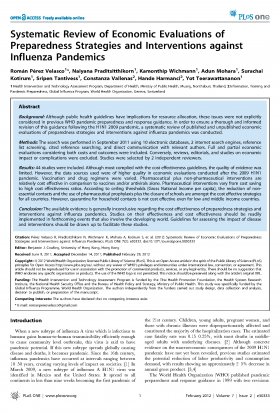This website uses cookies so that we can provide you with the best user experience possible. Cookie information is stored in your browser and performs functions such as recognising you when you return to our website and helping our team to understand which sections of the website you find most interesting and useful.
Systematic Review of Economic Evaluations of Preparedness Strategies and Interventions against Influenza Pandemics. (2012)

รายละเอียดเพิ่มเติม
Systematic Review of Economic Evaluations of Preparedness Strategies and Interventions against Influenza Pandemics.
Roma´n Pe´ rez Velasco1*, Naiyana Praditsitthikorn1, Kamonthip Wichmann1, Adun Mohara1, Surachai Kotirum1, Sripen Tantivess1, Constanza Vallenas2, Hande Harmanci2, Yot Teerawattananon1
1.Health Intervention and Technology Assessment Program, Department of Health, Ministry of Public Health, Muang, Nonthaburi, Thailand,
2.Information, Training and Pandemic Preparedness, Global Influenza Program, World Health Organization, Geneva, Switzerland
Abstract
Background: Although public health guidelines have implications for resource allocation, these issues were not explicitly considered in previous WHO pandemic preparedness and response guidance. In order to ensure a thorough and informed revision of this guidance following the H1N1 2009 pandemic, a systematic review of published and unpublished economic evaluations of preparedness strategies and interventions against influenza pandemics was conducted.
Methods: The search was performed in September 2011 using 10 electronic databases, 2 internet search engines, reference list screening, cited reference searching, and direct communication with relevant authors. Full and partial economic
evaluations considering both costs and outcomes were included. Conversely, reviews, editorials, and studies on economic impact or complications were excluded. Studies were selected by 2 independent reviewers.
Results: 44 studies were included. Although most complied with the cost effectiveness guidelines, the quality of evidence was limited. However, the data sources used were of higher quality in economic evaluations conducted after the 2009 H1N1 pandemic. Vaccination and drug regimens were varied. Pharmaceutical plus non-pharmaceutical interventions are relatively cost effective in comparison to vaccines and/or antivirals alone. Pharmaceutical interventions vary from cost saving to high cost effectiveness ratios. According to ceiling thresholds (Gross National Income per capita), the reduction of nonessential contacts and the use of pharmaceutical prophylaxis plus the closure of schools are amongst the cost effective strategies for all countries. However, quarantine for household contacts is not cost effective even for low and middle income countries.
Conclusion: The available evidence is generally inconclusive regarding the cost effectiveness of preparedness strategies and interventions against influenza pandemics. Studies on their effectiveness and cost effectiveness should be readily
implemented in forthcoming events that also involve the developing world. Guidelines for assessing the impact of disease and interventions should be drawn up to facilitate these studies.
Full text : http://www.ncbi.nlm.nih.gov/pubmed/22393352
http://www.plosone.org/article/fetchObjectAttachment.action?uri=info%3Adoi%2F10.1371%2Fjournal.pone.0030333&representation=PDF




